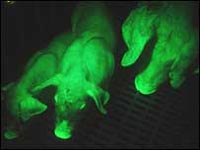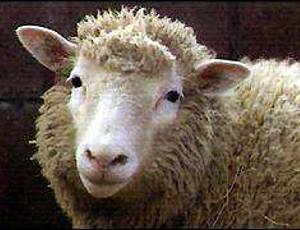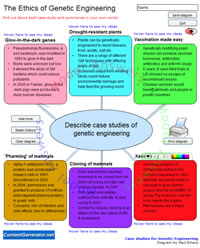Case studies of the following are included in the excellent book 'Engineering Genesis', the result of a collaboration of experts in the field of non-human genetic engineering for the Society, Religion and Technology Project:
|
Try completing the Genetic Engineering Case Studies diagram: |
Glowing Bacteria
Pseudomonas fluorescens, a common soil bacterium, was genetically modified in the early nineties to contain a gene which enables it to produce light under certain circumstances. GM bacteria could clean up pollutants and control plant diseases, so it would be useful to understand the bacteria better. If the bacteria glowed in the dark, it would be easier to study.
 The luminescent genes can be found in marine bacteria and higher organisms such as the jellyfish Aequorea victoria. Scientists have used these genes to produce rabbits and mice that glow in the dark. In 2006, it was announced that a research team in Taiwan had produced glow in the dark pig, which it was reported would be 'used in stem cell research and in the study of several human diseases.'
The luminescent genes can be found in marine bacteria and higher organisms such as the jellyfish Aequorea victoria. Scientists have used these genes to produce rabbits and mice that glow in the dark. In 2006, it was announced that a research team in Taiwan had produced glow in the dark pig, which it was reported would be 'used in stem cell research and in the study of several human diseases.'
There are two types of concern raised here. One is that the effects of GM are unknown, although the rsik in the case of soil bacteria seems minimal and is easily outweighed by potential benefits. The other type of concern is for the organism or animal concerned - whilst few ethical systems include concern for individual bacteria, some ethicists are concerned about harm done to mammals.
Genetically modifying plants for harsh environments
My uncle helped develop strains of grass that would grow in harsh conditions, As a child in the 1980s I remember growing Tibor's grass in the allotments at the end of our garden, as he needed to see how his grass grew under many different conditions.. Tibor moved to Bahrain, where he lived for years studying the adverse effects of heat, lack of humidity etc. Humans have for thousands of years used selective breeding, but this takes time. Enhanced breeding, where genetic information is used to inform selection, can save years.
Cytogeneticists now work at the level of plant chromosomes. Natural crossing produces thousands of chromosomes [1]. Cytogeneticists can mark, select and screen for individual chromosomes, such as the short arm of the rye 1R chromosome which carries disease-resistance genes.
Genetic engineering holds the promise of developing:
- Acidity and aluminium tolerance
- Frost tolerance
- Salt and drought tolerance
- Disease resistance
It isn't possible to simply claim that 'GM crops are unsafe and unethical'. Humans have been genetically modifying crops for thousands of years. We need to look at specific techniques such as identifying genetic markers for particular traits; introducing genes from other plant species, animals or humans etc.
There are also questions raised about the whole endeavour. If we produce a crop that is resistant to disease, salt, drought etc., it will be grown in large quantities, reducing biodiversity and increasing soil erosion (due to the increased tillage of poorer soils). These concerns need to be weighed against the benefits of being able to feed a growing world population.
There is concern that the process is driven by commercial concerns, benefitting wealthy countries only. Government-funded scientists, and those working in the commercial sector, claim that greater output from existing farms will mean less destruction to the wilderness (as less land will be needed) which will benefit the whole environment. While these scientists have been accused of bias, there is evidence to suggest that genetic modification techniques could be beneficial to the environment.
Dolly the sheep 
Dolly was the first reported mammal to have been cloned from an adult cell, by the Roslin Institute in Scotland. The controversial announcement was made in February 1997. Six years later, Dolly died.
Dolly was made by emptying an egg of its nucleus and inserting an adult cell in its place. The process is known as somatic cell nuclear transfer.
Much controversy surrounded every aspect of Dolly's life, particularly her premature aging. It appears that she was genetically six years old when she was born, so got arthritis at a very early age and died young.
The cloning of a sheep, and the problems it raised, makes any talk of developing a similar sort of technique in humans merely theoretical at this stage - scientists realise they need to refine the procedure before they would be allowed to try this with humans.
Citations:
1. 'Engineering Genesis': The Ethics of Genetic Engineering in Non-Human Species, p34


